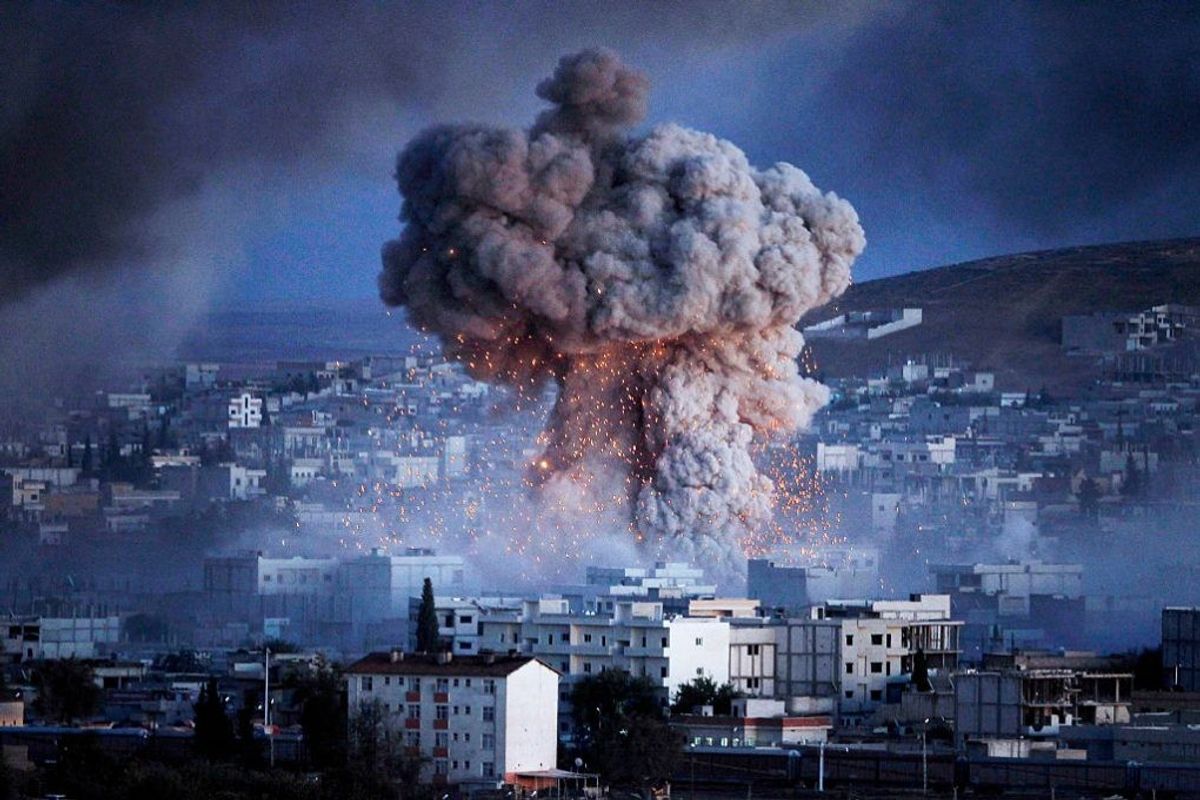Urban environments pose special challenges for counterinsurgency efforts as well as for complex operations against criminal gangs and drug trafficking operations. In Brazil, for example, the counter-crime operations have come to resemble counterinsurgency operations.
Efforts to oust insurgents from urban spaces come with particularly complex difficulties.
The most obvious challenge is distinguishing between insurgents or criminal gangs on the one hand, non-combatants on the other, and conducting operations in a way that scrupulously limit non-combatant casualties. The concentration of people in urban spaces, particularly megacities, complicates the counterinsurgents’ ability to separate local populations from insurgents and facilitates the insurgents’ use of human shields, as anti-Islamic State operations in Iraq and Syria have recently vividly demonstrated.
Insurgents are often highly indifferent to the civil casualties they themselves cause, blaming them on their opponents. They often purposefully seek to provoke the counterinsurgent forces to inflict civilian casualties as well. Yet, across the world, the political costs of civilian casualties tend to be far higher for governments than for the insurgents or criminal groups.
People simply expect better behavior from a government or an international coalition than they do from non-state actors, because governments are expected to represent the people, and formally recognized international actors are also perceived to have greater responsibility and accountability. Non-state actors are often expected to behave according to lesser standards on the rural or urban battlefield. At the same time, when non-state actors provide public goods, such as dispute resolution mechanisms and justice processes, as well as socio-economic services, however limited and rough, they often obtain significant political capital from local populations.
Military planners are dismayed that the collateral damage of their military efforts often gets condemned far more vociferously and is far more politically explosive than the far greater brutality and collateral damage caused by the non-state opponents. Yet that is the political reality on which they need to count.
This political reality, as well as the indispensable human rights obligation to minimize civilian casualties, inevitably limits the use of heavy weapons, artillery, and air power in urban spaces by the counterinsurgents. At the same time, the ability of non-state actors these days to deploy at least unmanned air assets, such as commercial drones, for reconnaissance – and increasingly for lethal action as ISIS already began to do in Iraq and Syria – may tempt the more powerfully-armed counterinsurgents to unleash the full potential of their destructive military capacity. Yet such a temptation needs to be resisted.
State actors that nonetheless resort to uncalibrated military power in urban spaces – such as the Syrian government and its ally Russia have done in cities such as Aleppo – may gain significant tactical advantage and even crush opposition groups in the short-term. But the long-term political costs and negative implications for successfully ruling the destroyed urban space are high, in addition to the moral consequences being unacceptable.
Somalia between 2006 and 2009 provides a vivid example. The very heavy-handed Ethiopian invasion in 2006 rapidly crushed the Islamic Courts Union (ICU) that had ruled the country for several years. However, Ethiopia’s indiscriminate and often highly repressive and bloody counterinsurgency operations, particularly in the densely urban capital of Mogadishu, failed to create a sustainable defeat of the jihadists and pacify either the city or the country.
Within months, a new insurgency emerged in the form of a greatly empowered al Shabaab – previously a fringe movement within the ICU, though also highly virulent and extensively connected to global jihadi terrorism. By 2009, the far more dangerous al Shabaab ruled Somalia. In other words, a heavy-handed indiscriminate counterinsurgency effort by Ethiopia against the ICU concentrated on Mogadishu – which was seemingly successful in the short term – left a far more potent threat in its wake.
Urban spaces where ethno-religious groups are diverse and highly intermixed limit not only the weapons and military methods that counterinsurgents can use, they can also limit the choice of native allies and proxy forces, such as local warlords and militia groups. Just like heavy weapons, such allies may prove effective in the short term in attacking and disrupting the insurgency or a bloody criminal group with territorial control. Yet, particularly if the local allies are drawn from a single ethno-religious group, they may prove highly repressive toward other groups in the city, causing not only large civilian casualties and engaging in plunder against their ethno-religious rivals, but also, once again, spawning a second wave of grievances and ultimately a new phase of military conflict.
Even urban warlords who seem to have effectively expelled insurgents from urban areas, established control, and who are often embraced by international coalition forces – for example, in Afghanistan, General Abdul Raziq in Kandahar and Matiullah Khan in Tirin Kot, and in Somalia, Ahmed Madobe in Kismayo – come with multiple problems. The effective anti-insurgent control is only as long-lived as the warlords themselves survive, as potently revealed following the Taliban takeover of much of Uruzgan after the assassination of Matiullah.
Second, and more profoundly, the means of governance the warlords adopt – both in urban and rural settings – are often so harsh and discriminatory against rival ethnic groups that, once again, provide a new justification of the rhetoric, raison d’etre, and political appeal of the insurgents. Both in Afghanistan and Somalia, the Taliban and al Shabaab have adroitly exploited the new resentments and cleavages created by warlords, attaining for themselves new leases on life.
Creating viable and acceptable holding forces in urban spaces is no easy task. In Rio de Janeiro, Brazil, for example, the so-called Pacification program that sought to retake the favelas, or slums, from drug-trafficking criminal gangs that controlled them since the 1980s, ultimately had to struggle to stand up a local, politically acceptable and effective community police.
The clearing operations were often undertaken by heavily militarized police forces called Batalhão de Operações Policiais Especiais (BOPE) that generated widespread resentment among the local population and limited their cooperation. But standing up brand new community police units – which given the space and favela population size, needed to number in the thousands, even tens of thousands – took far more time than planners assumed. In many “liberated” favelas, the resented BOPE was left for months or years with the need to hold it and provide street policing, while being unacceptable to the local population and creating new entrenchment opportunities for criminal gangs returning or seeping in from neighboring areas.
Finally, as the Pacification program also shows, delivering effective reconstruction in an urban space, particularly in slum areas disconnected from city centers, may prove to be a highly costly, complex, and long-term endeavor.
The Pacification program promised to deliver long-absent social economic services, such as better-quality schools, health care, electricity, water, sewage, internet, and transportation infrastructure, as well as legal jobs to employ the scores of young people otherwise susceptible to being recruited into criminal gangs. Yet, as with all such urban anti-crime projects and most counterinsurgency efforts, the delivery was slow, limited, and often ineffective. It has been also hampered by Brazil’s post-2012 economic malaise and the unwillingness of Brazil’s middle class to carry the tax burden for favela development. Legal jobs for favela residents have not materialized
Several broad implications can thus be derived for counterinsurgency operations in urban spaces and complex operations against criminal gangs ruling parts of cities. First, the development of non-lethal technologies for waging combat in such spaces is imperative.
Second, despite the temptations and short-term urban battlefield exigencies, a scrupulous adherence to avoiding non-combatant casualties is vital in terms of basic human right standards, as well as political sustainability of counterinsurgency efforts and a long-term viability of pacification. That limits not only the choice of weapons, but also the choice of allies. If local militias or warlords are recruited for counterinsurgency operations, the formal counterinsurgent forces need to be ready and willing to disarm them after the campaign’s completion and promote accountable, equitable, and non-discriminatory governance.
Finally, planning for post-combat reconstruction needs to assume it will be a long-term, expensive, and complex effort – particularly for megacities with fatally damaged economies and infrastructures. For urban slums, the planning should often be for decades, not years, and an effort needs to be made to obtain funding for such a long-term enterprise. Out of the many development challenges, creating legal jobs in slums is the most vexing one. But in the absence of serious reconstruction efforts, at best, criminal gangs and illicit economies will emerge, and at worst, new militants will move in. Both will violently challenge the stability of the post-counterinsurgency political arrangements.
In sum, military actions to defeat or rout insurgents who are in control of or holed up in urban areas differ in three crucial respects from COIN operations against insurgent forces in relatively sparsely populated deserts, planes, mountains, or jungles. First, counterinsurgent forces encounter much greater difficulty in distinguishing the insurgents and their allies from the population to be liberated.
Second, lethal operations with the greatest prospect of immediate battlefield effectiveness will likely produce collateral damage that can turn the population against their liberators and thus undermine the presumed success in the medium term.
Third, the post-combat conditions needing massive reconstruction will require skilled and reliable locals, the identification and recruitment of whom will be a daunting challenge, as well as vast sustained resources over years and decades.








